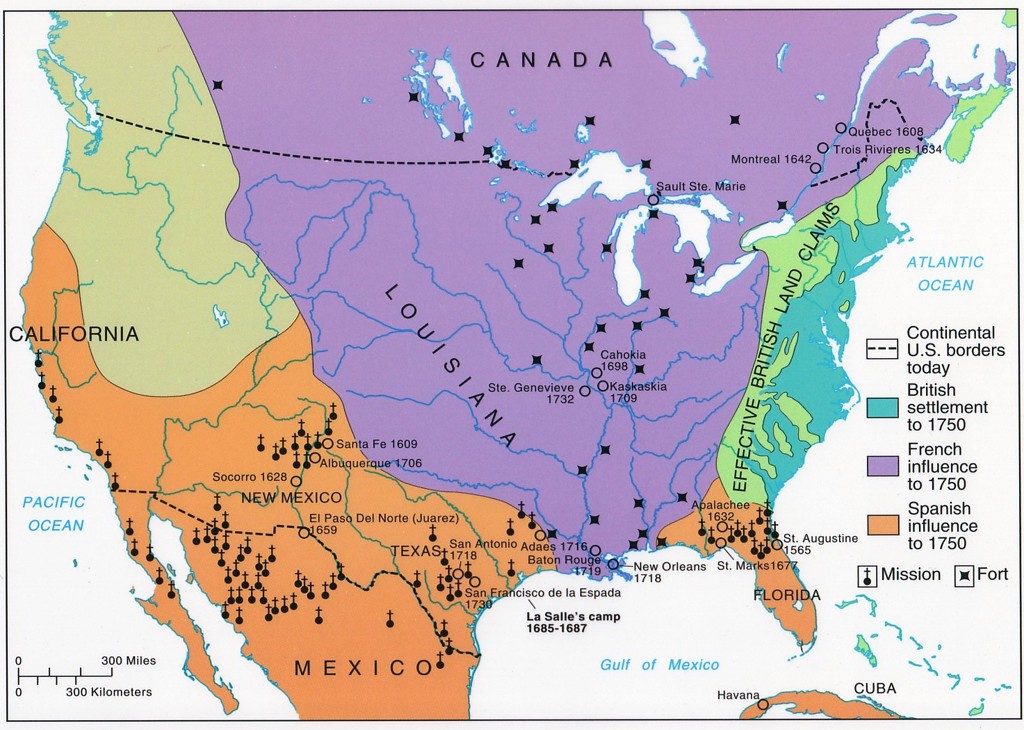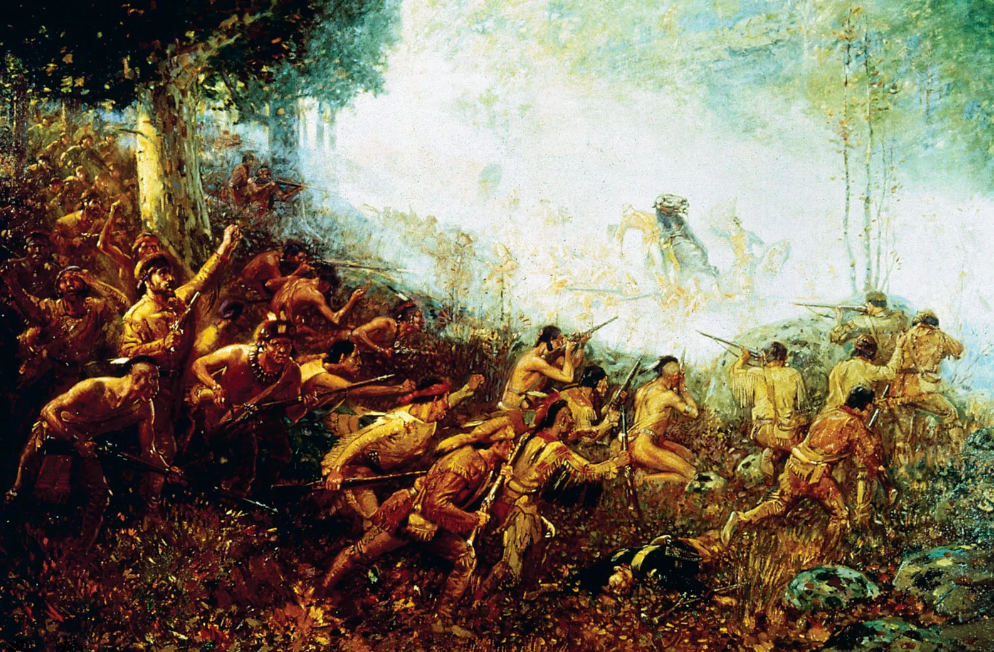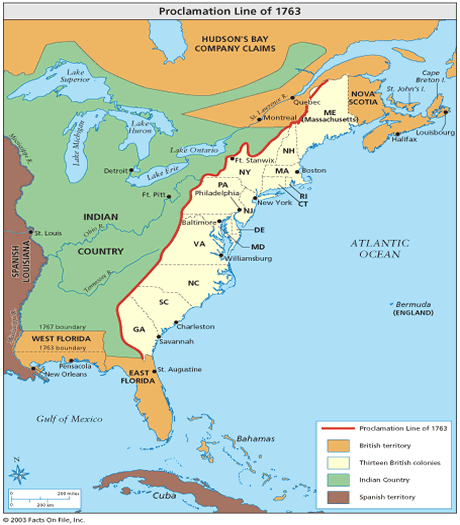3.2 The Seven Years’ War (The French and Indian War)
7 min read•june 18, 2024
Dalia Savy
J
James Glackin
AP US History 🇺🇸
454 resourcesSee Units
The Seven Years' War was a global conflict that involved various European powers and their colonies. It was the last major conflict prior to the revolutionary period in history (which included the American Revolution) and lasted from 1756 to 1763.
Causes of the Seven Years' War
By 1754, European countries were competing for world domination by dueling for land in North America. Great Britain, France, and Spain all held various areas in the New World. This competition would disrupt the lives of both American colonists and Native Americans.

North America in 1750. Image Courtesy of Alphahistory
Generally, Britain would fight against either France, Spain, or both. Prior to the French and Indian War, Britain would fight the French over New France (Canada) and their French charismatic beaver trappers, who were expanding their travels into contested lands. France lost a lot of their territory in New France, but Native Americans especially suffered in these early conflicts.
By 1754, the Ohio Valley became a hotspot for conflict. The British saw this area as their gateway to western expansion, and the French viewed it as their vital link between their possessions in Canada and the Lower Mississippi Valley.
Western Pennsylvania would become the sight of the first shots of the French and Indian War, a conflict pitting the British and their Iroquois Indian allies against the French and their Huron Indian allies. This was part of the larger worldwide war between the British and French known as the Seven Years' War. George Washington, a young Lt. Colonel from a wealthy Virginia family, was sent by the Governor of Virginia to an area near Ft. Duquesne (Pittsburgh) to lay claim to this land. Washington engaged French troops in a 10-hour battle and was defeated by French forces at nearby Fort Necessity in 1754.
In the same summer of 1754, the British created a meeting for the colonies in Albany, New York. Their motive was to entice the Iroquois Indians to remain their allies and also to unify the disjointed 13 colonies against their French enemies.
Ben Franklin, the “First American,” famed patriot, and future Founding Father, represented Pennsylvania as one of the seven colonies to attend. Note that yes, only seven of the thirteen colonies sent representatives to the Albany Congress.
Franklin’s Albany Plan attempted to establish a colonial government based on home rule. It called for three things:
- A Grand Council would be formed with elected representatives from the different colonies to oversee matters of common defense, western expansion, and Indian affairs.
- A President General would be established and appointed by the King who would preside. They would have the power to veto decisions made by the Grand Council.
- The Council would be authorized to collect taxes for military expenditures.
The Albany Plan was seen as a radical proposal at the time, as it called for a level of colonial unity and self-governance that was unprecedented. It was ultimately rejected by the British government and the colonies, but it is considered an important early attempt to address the growing tensions between the colonies and the mother country and to find a way for the colonies to work together for their mutual benefit. The colonists felt it did not give them enough authority, while London argued it gave them too much.

Image Courtesy of Wikipedia
The above political cartoon is one of the "first" U.S. political cartoons, and it was created by Ben Franklin. It highlighted the need for colonial unity as he promoted the Albany Plan.
Major Events Surrounding the French and Indian War
The Battle of Fort Necessity was the first major engagement of the war in which the British colonists, led by George Washington, were defeated by French and Native American forces. This was the first attempt to evict the French from the Ohio River Valley; let's now discuss the second.
General Braddock's Expedition
General Edward Braddock was a British army officer who was sent to North America during the French and Indian War to expel the French from the Ohio River Valley. In 1755, he led a large expeditionary force that included British regulars, colonial militia, and native allies, with the goal of capturing the French fort at Fort Duquesne.
Braddock's expedition was a disaster from the start. The British and colonial troops were not used to fighting in the dense forests of North America and were unfamiliar with the guerrilla tactics used by the French and their native allies. The expedition was also beset by logistical problems, including a shortage of supplies and difficulties in getting the heavy artillery needed to besiege the fort across the rough terrain.

Image Courtesy of Britannica
Despite these challenges, Braddock pressed on with his attack on Fort Duquesne. On July 9, 1755, his forces were ambushed by a French and native force led by Captain Daniel Liénard de Beaujeu. The British and colonial troops were caught off guard and suffered heavy losses, including the death of General Braddock himself. The survivors retreated in disarray, and the expedition was a complete failure.
The defeat at the Battle of the Monongahela, as it came to be known, was a major setback for the British in the French and Indian War. It also had significant consequences for the future of North America, as the failure of Braddock's expedition emboldened the French and their native allies, who went on to inflict further defeats on the British in the years that followed.
Note that this occurred in 1755, which was one year before the war was formally declared in 1756. Remember, Native American tribes continued to exploit both the British and French forces during this ongoing conflict.
British-American Colonial Tensions
| Colonials | British | |
| Methods of Fighting | Native American guerrilla tactics | March in formation or bayonet charge |
| Military Organization | Colonial militias served under their own captains | British officers wanted to take charge of colonials |
| Military Discipline | No military deference or protocols observed | Drills and tough discipline |
| Finances | Resistance to the rising taxes | Colonists should pay for their own defense |
| Demeanor | Causal, very nonprofessional | British officers with servants and tea settings |
The Tide Turned
As newly instated Prime Minister and Minister for War, William Pitt implemented a number of significant changes to Britain's military and foreign policy. He increased funding for the military and implemented a number of reforms to improve its efficiency, including the creation of a professional officer corps and the establishment of a system for purchasing commissions (which helped to reduce corruption and nepotism in the ranks).
Pitt also oversaw the deployment of large numbers of British troops to North America, where they were able to achieve a number of important victories against the French and their native allies. These victories, combined with the successful defense of Britain's North American colonies against French and native attacks, helped to turn the tide of the war in favor of the British.
Pitt understood colonial concerns and offered them a compromise, seeing these conflicts as a way to expand the British empire. He ended up reimbursing colonial assemblies for their costs, which raised colonial morale by 1758, enabling these victories.
The End of the War
After many British victories, the British closed in on Quebec. The British had been trying to capture the city of Quebec for some time, as it was a key strategic location that controlled the approaches to the Great Lakes and the Mississippi River.
The battle of Quebec was fought on the plains of Abraham and was fought between the British army, led by General James Wolfe, and the French army, led by General Louis-Joseph de Montcalm. The battle was relatively short, lasting just a few hours, but it was fiercely fought. Both Wolfe and Montcalm were mortally wounded in the conflict, and their deaths had a significant impact on the outcome of the war. The French army was decisively defeated, and the British captured the city of Quebec soon thereafter.
The Battle of Quebec was a major turning point in the French and Indian War, as it effectively ended French resistance in North America. The British went on to win a series of further victories in the war, and the conflict ultimately ended with the signing of the Treaty of Paris in 1763, which recognized British control over much of the territory that had been in dispute.
The Treaty of Paris in 1763
Under the terms of the treaty, France ceded its territories in Canada and its claims to the land west of the Mississippi to Britain, as well as its sugar islands in the Caribbean. France also ceded its claims to the Indian trading posts of Fort Niagara and Fort Detroit to Britain.
Spain, which became an ally of France in 1761, ceded Florida to Britain in exchange for the return of Havana, Cuba, which had been captured by the British earlier in the conflict. They got all French lands west of the Mississippi River and New Orleans.
The transfer of so much territory from France to Britain marked the beginning of the British Empire in North America.
Consequences of the French and Indian War
The aftermath of the French and Indian War would help to cause the American Revolutionary War between the colonists and the British. The colonists no longer had to deal with the French in the Ohio River Valley, and they felt compelled to travel and settle in the west.
However, the British had other plans for their subordinates. Surprisingly, the British issued the Proclamation of 1763. This act prohibited the colonists from traveling beyond the Appalachian Mountains. The British felt that this would prevent problems with the Native Americans, but the colonists detested this restrictive law and broke it at will.

The Proclamation Line (red line) of 1763. Image Courtesy of Sutori
Furthermore, the French and Indian War gave the American colonists a sense of confidence and a desire for independence. The British viewed this as arrogance and insubordination.
Most importantly, the French and Indian War would cost the British a substantial amount of money. How would they pay for these war debts? Increasing colonial taxes would seem to be a solution, but it would create both ideological and financial conflicts between the upstart colonists and the Royal Crown.
Browse Study Guides By Unit
🌽Unit 1 – Interactions North America, 1491-1607
🦃Unit 2 – Colonial Society, 1607-1754
🔫Unit 3 – Conflict & American Independence, 1754-1800
🐎Unit 4 – American Expansion, 1800-1848
💣Unit 5 – Civil War & Reconstruction, 1848-1877
🚂Unit 6 – Industrialization & the Gilded Age, 1865-1898
🌎Unit 7 – Conflict in the Early 20th Century, 1890-1945
🥶Unit 8 – The Postwar Period & Cold War, 1945-1980
📲Unit 9 – Entering Into the 21st Century, 1980-Present
📚Study Tools
🤔Exam Skills
👉🏼Subject Guides
📚AMSCO Notes

Fiveable
Resources
© 2025 Fiveable Inc. All rights reserved.